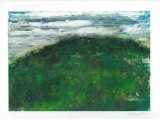The First Bohemian: Homage to Henry (Henri) Murger
Homage to Henry Murger:
I refer to the French author Henry Murger, and universally accepted “first bohemian,” living in Paris, France in My Father’s Room and The Four Seasons of the Master Myth. I wrote: “Henry Murger (1822-1861), often considered the first Bohemian, wrote about climbing the green hillside in the springtime of our youth .” As a visual artist, now very senior in age, I can look back and see that my painting days have produced a hundred or more paintings that express a hillside and a predominant green color. Thinking of this fact has promoted me to search around in my data storage for those images, and display a few of them on this gallery room: In honor of Henry Murger.
In his novel Scenes de la vie de boheme, Murger captured the heart of what is meant to be a Bohemian, the spirit of the artist boheme; his novel made him famous. Murger’s struggle so epitomizes the journey of the artist’s life that I felt compelled to direct attention back to that’ spirit,’ especially in these times when commercial interests dominates the art scene world-wide; most often you can grasp the significance of this by the outrageous prices art brings in auction houses, and the corporate control by art syndicated market driven individuals.
So, Henry, I think we artists owe you a salute: While I didn’t have his name in mind when I did this painting; I did have your spirit in mind, and your struggle as witness to your life in art.
Biography from Wikepedia:
Murger was born and died in Paris. He was the son of a Savoyard immigrant who worked as a tailor and janitor for an apartment building in the Rue Saint Georges. He had a scanty and fragmented education. After leaving school at 15 he worked in a variety of menial jobs before securing one in a lawyer’s office. While there he also wrote poetry which came to the attention of the French writer Étienne de Jouy. De Jouy’s connections enabled him to secure the position of secretary to Count Tolstoi, a Russian nobleman living in Paris. Murger’s literary career began about 1841. His first essays were mainly literary and poetic, but under the pressure of earning a living he wrote whatever he could find a market for, turning out prose as he put it, “at the rate of eighty francs an acre”.[2] At one point he edited a fashion newspaper, Le Moniteur de la Mode, and a paper for the millinery trade, Le Castor. His position gradually improved when the French writer Champfleury, with whom he lived for a time, urged Murger to devote himself to fiction. His first big success was Scènes de la vie de bohème. In 1851 Murger published a sequel, Scènes de la vie de jeunesse. Several more works followed, but none of them brought him the same popular acclaim.
 Salazar
Salazar

